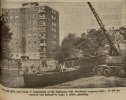M
Malcog
Guest
A few years ago my son was exploring the stream at the back of the Daffodil Park behind the old Kalamazoo works in Northfield and he said he found big lumps of iron. I went along to see this and there were large pieces (several tons) of iron slag in the bed of the stream that runs alongside the railway. I looked in Northfield library and the internet for any mentions of iron/steel working on the upper Rea but found nothing. However, there is a Steel Road running down to Mill Lane, so maybe that is an indicator of some sort of metalworking.
Does anyone have any information of iron or steem making in this part of Northfield ?
Does anyone have any information of iron or steem making in this part of Northfield ?

